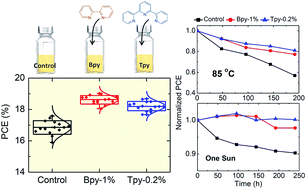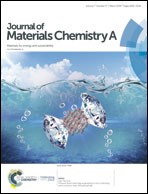Effect of bidentate and tridentate additives on the photovoltaic performance and stability of perovskite solar cells†
Abstract
Fabrication of high-quality perovskite films with a large grain size and fewer defects is always crucial to achieve efficient and stable perovskite solar cells (PSCs). Here, we report a simple and effective method for crystal growth and defect passivation via additive engineering. It is found that bidentate ligand 2,2′-bipyridine (Bpy) and tridentate ligand 2,2′:6′,2′′-terpyridine (Tpy) show a positive effect on the power conversion efficiency (PCE) while a negative effect is observed for monodentate pyridine (Py). Bpy or Tpy additives increase the grain size and carrier lifetimes, which indicates that the degree of interaction between Lewis acid species in the precursor solution and pyridine derivatives plays a critical role in modulating grain growth and passivating defects. Moreover, device stability is improved upon introduction of Bpy or Tpy additives, which is mainly ascribed to suppressed trap-assisted non-radiative recombination as a consequence of reduced defect density. This work highlights the importance of rational engineering of additives for the purpose of simultaneous realization of morphological improvement and defect passivation in efficient and stable PSCs.



 Please wait while we load your content...
Please wait while we load your content...